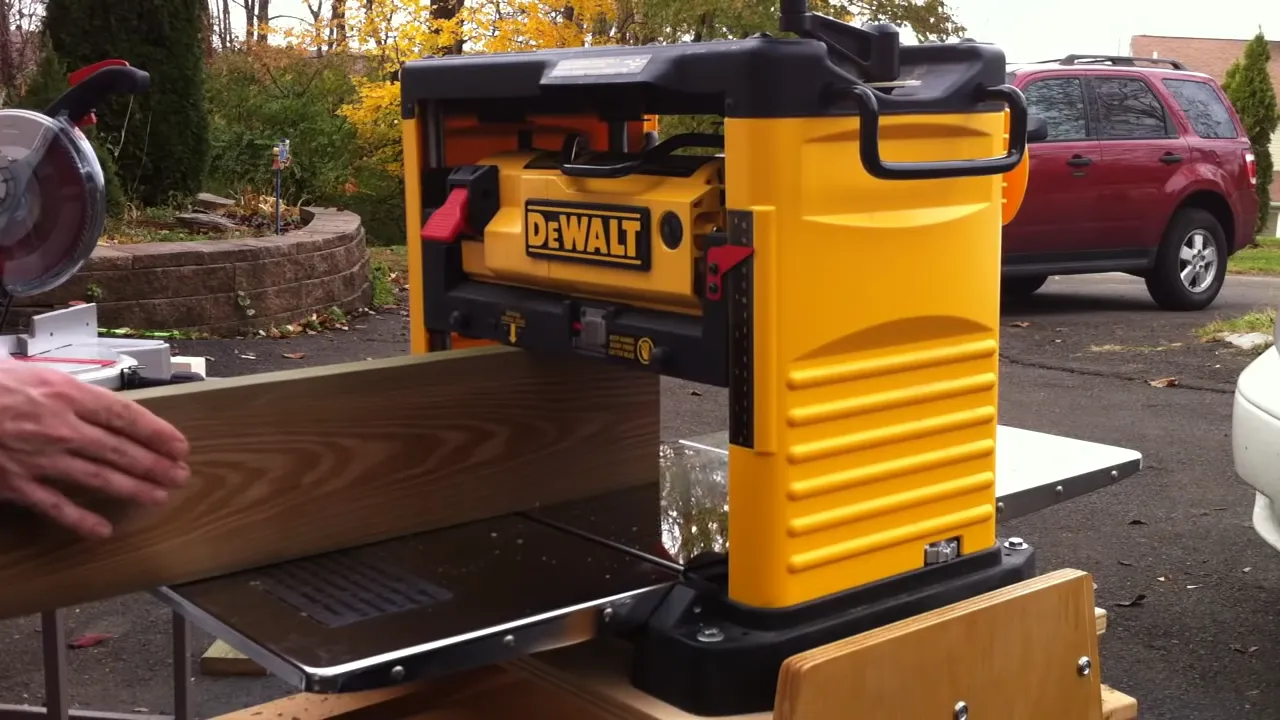13 Reasons Why Benchtop Planers Are Worth It!
Hey there fellow woodworking enthusiasts! If you’ve been pondering the idea of getting a benchtop planer for your woodworking shop, I’m here to share my experiences and give you some great reasons why it might just be the best decision you’ll make for your craft. I’ve been through the same decision-making process, and let me tell you, investing in a thickness planer has been an absolute game-changer for me. So, let’s dive into why you should seriously consider adding this must-have tool to your arsenal!

1. Save Money
Okay, I know the initial investment might seem a bit daunting, but trust me, a thickness planer will save you a ton of money in the long run. By milling your rough lumber yourself, you can purchase more affordable rough-cut lumber instead of the pricier surfaced 4 sides (S4S) boards. Typically, S4S lumber can cost anywhere from 30% to 50% more than rough-cut lumber. So, if you have several woodworking projects lined up or love building furniture, a planer will quickly pay for itself. I personally started with the Dewalt DW735X, and though it was an investment, the money I saved on lumber made it totally worth it.
2. Consistent Results
Having a thickness planer allows you to flatten boards to the exact same thickness consistently. This is crucial for building furniture, table tops, or any large projects that require panel glue-ups. When you purchase surfaced lumber from a store, you might encounter boards of varying thicknesses, which can cause issues in your project. With your own planer, you can dial in the perfect thickness for each board, ensuring more consistent and precise results. Say goodbye to misaligned parts!
3. Flatten Projects or Glue-Ups
A major benefit of a thickness planer is its ability to create a flat surface, which is essential for working with large projects, wood slabs, or intricate glue-ups. Sure, you might be able to flatten one face of a board with a belt sander or hand plane, but without a planer, achieving parallel surfaces can be a daunting task. I’ve personally used my planer to create a beautiful chevron patterned cutting board, and it wouldn’t have been possible without this fantastic tool.
4. Use Your Own or Local Lumber
Owning a planer gives you the freedom to use your own lumber or get rough-cut lumber from your local lumber mill or fellow woodworkers. This means you can choose high-quality lumber and even harvest your own if you have access to a sawmill. Personally, the limited availability of surfaced lumber in my area drove me to get a planer, and now I can source wood from local independent sawmills and major suppliers near my shop. Having a planer also allows you to ensure the quality of the wood you use, giving you more control over your projects.
5. Unlimited Customization
With a planer, you have the power to dial in the specific thickness of wood you need for each project. If you’re limited to purchasing pre-surfaced wood stock, you’re stuck with standard construction measurements for softwoods and a limited supply of hardwoods, mostly in 3/4″ thicknesses. However, with a benchtop thickness planer, you have the versatility to choose the exact thickness you desire for each individual project. No more restrictions on your creativity!
6. Unique Applications
Having a planer in your shop opens up a world of possibilities for unique woodworking projects, especially using materials not available in big box stores. You can take reclaimed barn wood, for example, and knock down the high points with the planer to achieve a rustic yet smooth-looking material. Embrace the imperfections, as they can add character and charm to your creations. I’ve personally repurposed pallet wood, old cherry lumber, and barn wood using my planer, and the results have been amazing.
7. Save Time Compared to Hand Tools
While a planer may not be the fastest tool out there, it’s still considerably faster than using hand tools for milling rough stock. Sure, it might take some time, especially with larger amounts of rough-cut lumber, but it’s a significant time-saver compared to manual labor. Plus, using a benchtop planer doesn’t require the same level of skill and physical effort as a hand planer, making it much more accessible to woodworkers of all levels.
8. Control the Quality of Your Wood
When you buy lumber from a store, you can’t always be certain of its quality. It’s not uncommon to find knots, warping, or other imperfections in store-bought lumber. However, with your own planer, you have the power to inspect and choose the best pieces of rough lumber for your projects. This way, you can ensure that your creations are crafted from the finest materials, resulting in a higher-quality finished product.
9. Achieve Custom Thicknesses
Sometimes, your woodworking projects require non-standard thicknesses that are simply not available in pre-surfaced lumber. With a thickness planer, you have the freedom to mill your lumber to any thickness you need, allowing for greater design flexibility and customization.
10. No More Stock Limitations
By owning a planer, you are no longer restricted to the limited selection of pre-surfaced lumber available in stores. You can now explore a wider range of lumber options, including unique species, sizes, and textures, making your projects truly one-of-a-kind.
11. Sustainability & Eco-Friendly
Using rough-cut lumber and milling it to your desired thickness reduces waste, making it a more sustainable and eco-friendly option. By controlling the thickness of your boards, you can make the most of the available wood and minimize scrap.
12. Improve Your Woodworking Skills
Operating a thickness planer might seem intimidating at first, but with practice, it becomes a valuable skill in your woodworking toolkit. You’ll gain confidence in working with different types of wood and understanding how to achieve the best results with your planer.
13. Long-Term Investment
Lastly, think of a benchtop planer as a long-term investment. If you’re serious about woodworking and plan to stick with it, a quality planer will serve you for many years to come, constantly adding value to your projects and woodworking journey.
Alternatives to Using a Planer
Now, if you’re not ready to make the leap into purchasing a benchtop planer, don’t worry! You have some viable alternatives to consider. One of the best options is to purchase S2S (Surfaced Two Sides) or S4S (Surfaced Four Sides) lumber from a local lumber yard. This way, you’ll have wood that’s already planed to a uniform thickness and smooth surface, which can be a great starting point for your projects. Additionally, for smaller projects where you only need to plane the face of a board or two, hand tools can get the job done. But for larger projects, electric planers are the way to go.
FAQs on Planers
Let’s address some common questions you might have about planers:
1. What is the best type of cutting head for a planer?
Power planers come with different types of cutting heads, including straight knife blades, spiral cutter heads, and helical heads. While straight knife blades are found on budget planers and work well, they tend to dull quickly and are prone to nicks. Spiral cutter heads, with rows of small square carbide inserts in a spiral pattern, offer longer lifespans and less maintenance. However, if you want the best cutting head, go for the helical head planers, which have tilted square carbide inserts in a spiral pattern. They produce the cleanest surface on the wood, allowing you to use the wood directly from the planer without sanding.
2. Should you get a wood jointer or planer?
The debate between a jointer and a planer is common in woodworking circles. If you’re unsure which one to get first, consider this: if you have access to high-quality kiln-dried rough-cut lumber, a planer can often circumvent the need for a jointer, especially for basic milling. However, if you’re building cabinets, doors, or anything requiring perfectly straight and flat boards, a stationary jointer is essential.
3. What is the difference between a planer and jointer?
A planer is used to smooth and level the flat surfaces of a board to a consistent thickness, while a jointer is used to create a square edge on the board’s edge. Jointers are also used to face joint one side of the board, which allows the planer to create parallel surfaces with uniform thickness. A jointer can also flatten a board with a twist, bow, or cup, while a planer can only thickness one side relative to the other face of the board.
4. What is the proper method to mill lumber?
The correct way to mill lumber is to first use a jointer to face joint one side of the board, producing the first flat surface. Next, joint a flat edge with the previously face jointed side against the jointer’s fence. Then, using a planer with the face jointed side down on the jointer bed, run the board through to the desired thickness, planing down the second face. Finally, use a table saw to trim the last rough edge of the board, resulting in perfectly square lumber.
5. Should you buy a used thickness planer?
Buying a used planer can be a great option, but there are a few things to consider. First, check the condition of the machine. If it’s in good shape, it’s likely to work well and last a long time. However, be cautious of any surface rust or corrosion, as that could indicate potential problems. As long as the planer is in good working condition and has been well-maintained, it can be an excellent way to save money and get a reliable tool for your woodworking endeavors.
I hope this article has shed some light on the many reasons why a benchtop planer is worth its weight in gold for serious woodworkers. Whether you’re saving money, improving your skills, or embracing the creative possibilities, a planer will become an indispensable tool in your shop. Don’t be afraid to take the plunge and invest in a high-quality planer that will serve you well for years to come. Happy woodworking!



